SLIS032B July 1995 – June 2015 TPIC6B595
PRODUCTION DATA.
- 1 Features
- 2 Applications
- 3 Description
- 4 Revision History
- 5 Pin Configuration and Functions
- 6 Specifications
- 7 Parameter Measurement Information
- 8 Detailed Description
- 9 Application and Implementation
- 10Power Supply Recommendations
- 11Layout
- 12Device and Documentation Support
- 13Mechanical, Packaging, and Orderable Information
Package Options
Mechanical Data (Package|Pins)
Thermal pad, mechanical data (Package|Pins)
Orderable Information
6 Specifications
6.1 Absolute Maximum Ratings
over operating free-air temperature range (unless otherwise noted) (1)| MIN | MAX | UNIT | ||
|---|---|---|---|---|
| VCC | Logic supply voltage(2) | –0.3 | 7 | V |
| VI | Logic input voltage | –0.3 | 7 | V |
| VDS | Power DMOS drain-to-source voltage(3) | –0.3 | 50 | V |
| Continuous source-to-drain diode anode current | 0 | 500 | mA | |
| Pulsed source-to-drain diode anode current(4) | 0 | 1 | A | |
| ID | Pulsed drain current, each output, all outputs ON, TC = 25°C(4) | 0 | 500 | mA |
| ID | Continuous drain current, each output, all outputs ON, TC = 25°C(4) | 0 | 150 | mA |
| IDM | Peak drain current single output, TC = 25°C(4) | 0 | 500 | mA |
| EAS | Single-pulse avalanche energy (see Figure 11) | 0 | 30 | mJ |
| IAS | Avalanche current(5) | 0 | 500 | mA |
| Continuous total dissipation | See Thermal Information | |||
| TJ | Operating virtual junction temperature | –40 | 150 | °C |
| TC | Operating case temperature | –40 | 125 | °C |
| Tstg | Storage temperature | –65 | 150 | °C |
(1) Stresses beyond those listed under Absolute Maximum Ratings may cause permanent damage to the device. These are stress ratings only, which do not imply functional operation of the device at these or any other conditions beyond those indicated under Recommended Operating Conditions. Exposure to absolute-maximum-rated conditions for extended periods may affect device reliability.
(2) All voltage values are with respect to GND.
(3) Each power DMOS source is internally connected to GND.
(4) Pulse duration ≤ 100 μs and duty cycle ≤ 2%.
(5) DRAIN supply voltage = 15 V, starting junction temperature (TJS) = 25°C, L = 1.5 H, IAS = 200 mA (see Figure 11).
6.2 ESD Ratings
| VALUE | UNIT | ||||
|---|---|---|---|---|---|
| V(ESD) | Electrostatic discharge | Human-body model (HBM), per AEC Q100-002(1) | ±2000 | V | |
| Charged-device model (CDM), per AEC Q100-011 | All pins | ±500 | |||
| Corner pins (1, 10, 20, 11) | ±750 | ||||
(1) AEC Q100-002 indicates that HBM stressing shall be in accordance with the ANSI/ESDA/JEDEC JS-001 specification.
6.3 Recommended Operating Conditions
over operating free-air temperature range (unless otherwise noted)| MIN | NOM | MAX | UNIT | ||
|---|---|---|---|---|---|
| VCC | Logic supply voltage | 4.5 | 5.5 | V | |
| VIH | High-level input voltage | 0.85 VCC | V | ||
| VIL | Low-level input voltage | 0.15 VCC | V | ||
| Pulsed drain output current, TC = 25°C, VCC = 5 V, all outputs on(1)(2) (see Figure 7) | –500 | 500 | mA | ||
| tsu | Setup time, SER IN high before SRCK↑ (see Figure 9) | 20 | ns | ||
| th | Hold time, SER IN high after SRCK↑, (see Figure 9) | 20 | ns | ||
| tw | Pulse duration (see Figure 9) | 40 | ns | ||
| TC | Operating case temperature | –40 | 125 | °C | |
(1) Pulse duration ≤ 100 μs and duty cycle ≤ 2%.
(2) Technique should limit TJ − TC to 10°C maximum.
6.4 Thermal Information
| THERMAL METRIC(1) | TPIC6B595 | UNIT | ||
|---|---|---|---|---|
| DW (SOIC) | N (PDIP) | |||
| 20 PINS | 20 PINS | |||
| RθJA | Junction-to-ambient thermal resistance | 75.3 | 57 | °C/W |
| RθJC(top) | Junction-to-case (top) thermal resistance | 39.8 | 58.5 | °C/W |
| RθJB | Junction-to-board thermal resistance | 43.1 | 38 | °C/W |
| ψJT | Junction-to-top characterization parameter | 15.4 | 25.2 | °C/W |
| ψJB | Junction-to-board characterization parameter | 42.6 | 37.9 | °C/W |
(1) For more information about traditional and new thermal metrics, see the Semiconductor and IC Package Thermal Metrics application report, SPRA953.
6.5 Electrical Characteristics
over operating free-air temperature range (unless otherwise noted)| PARAMETER | TEST CONDITIONS | MIN | TYP | MAX | UNIT | ||
|---|---|---|---|---|---|---|---|
| V(BR)DSX | Drain-to-source breakdown voltage | ID = 1 mA | 50 | V | |||
| VSD | Source-to-drain diode forward voltage | IF = 100 mA | 0.85 | 1 | V | ||
| VOH | High-level output voltage, SER OUT | IOH = −20 µA, | VCC = 4.5 V | 4.4 | 4.49 | V | |
| IOH = −4 mA, | VCC = 4.5 V | 4 | 4.2 | ||||
| VOL | Low-level output voltage, SER OUT | IOL = 20 µA, | VCC = 4.5 V | 0.005 | 0.1 | V | |
| IOL = 4 mA, | VCC = 4.5 V | 0.3 | 0.5 | ||||
| IIH | High-level input current | VCC = 5.5 V, | VI = VCC | 1 | µA | ||
| IIL | Low-level input current | VCC = 5.5 V, | VI = 0 | –1 | µA | ||
| ICC | Logic supply current | VCC = 5.5 V | All outputs OFF | 20 | 100 | µA | |
| All outputs ON | 150 | 300 | |||||
| ICC(FRQ) | Logic supply current at frequency | fSRCK = 5 MHz, All outputs off, |
CL = 30 pF, See Figure 9 and Figure 2 |
0.4 | 5 | mA | |
| IN | Nominal current | VDS(on) = 0.5 V, IN = ID, TC = 85°C |
See (1)(2)(3) | 90 | mA | ||
| IDSX | OFF-state drain current | VDS = 40 V, | VCC = 5.5 V | 0.1 | 5 | µA | |
| VDS = 40 V TC = 125°C |
VCC = 5.5 V |
0.15 | 8 | ||||
| rDS(on) | Static drain-source ON-state resistance | ID = 100 mA, VCC = 4.5 V |
See (1) and(2) and Figure 3 and Figure 4 | 4.2 | 5.7 | Ω | |
| ID = 100 mA, TC = 125°C, VCC = 4.5 V |
6.8 | 9.5 | |||||
| ID = 350 mA, VCC = 4.5 V |
5.5 | 8 | |||||
(1) Technique should limit TJ − TC to 10°C maximum.
(2) These parameters are measured with voltage-sensing contacts separate from the current-carrying contacts.
(3) Nominal current is defined for a consistent comparison between devices from different sources. It is the current that produces a voltage drop of 0.5 V at TC = 85°C.
6.6 Switching Characteristics
VCC = 5 V, TC = 25°C| PARAMETER | TEST CONDITIONS | MIN | TYP | MAX | UNIT | |
|---|---|---|---|---|---|---|
| tPLH | Propagation delay time, low-to-high-level output from G | CL = 30 pF, ID = 100 mA, See Figure 5, Figure 8 and Figure 9 | 150 | ns | ||
| tPHL | Propagation delay time, high-to-low-level output from G | 90 | ns | |||
| tr | Rise time, drain output | 200 | ns | |||
| tf | Fall time, drain output | 200 | ns | |||
| ta | Reverse-recovery-current rise time | IF = 100 mA, di/dt = 10 A/µs(1)(2), See Figure 10 |
100 | ns | ||
| trr | Reverse-recovery time | 300 | ||||
(1) Technique should limit TJ − TC to 10°C maximum.
(2) These parameters are measured with voltage-sensing contacts separate from the current-carrying contacts.
6.7 Typical Characteristics
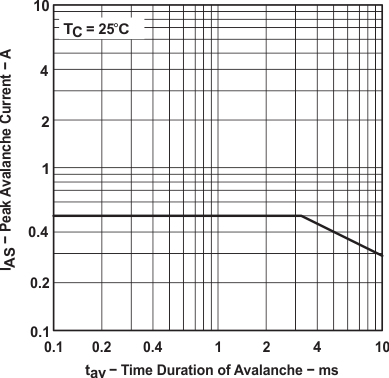
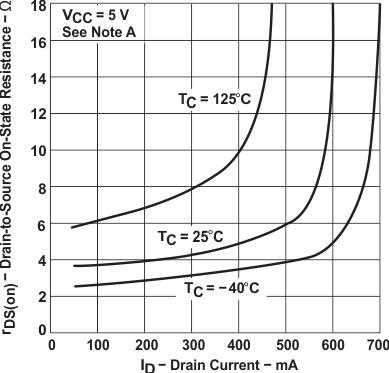
| Technique should limit TJ − TC to 10°C maximum. |
vs Drain Current
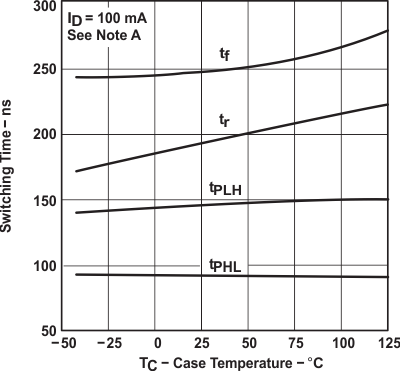
| Technique should limit TJ − TC to 10°C maximum |
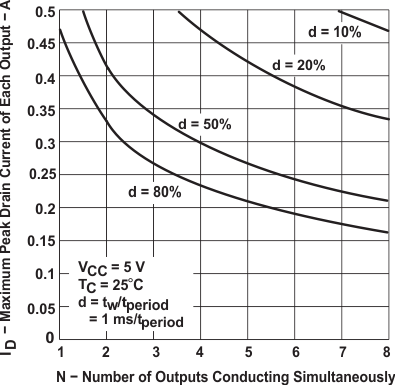
Each Output vs Number of Outputs Conducting Simultaneously
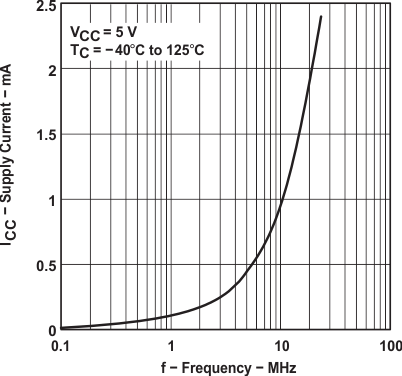
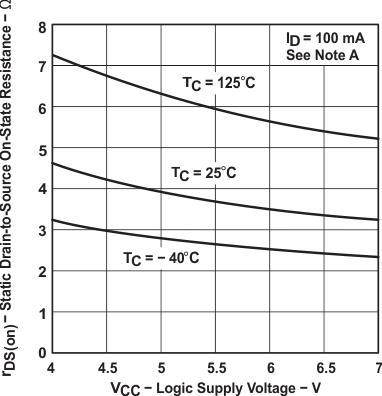
| Technique should limit TJ − TC to 10°C maximum. |
vs Logic Supply Voltage
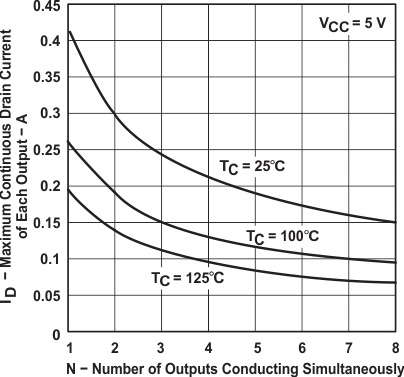
Each Output vs Number of Outputs Conducting Simultaneously